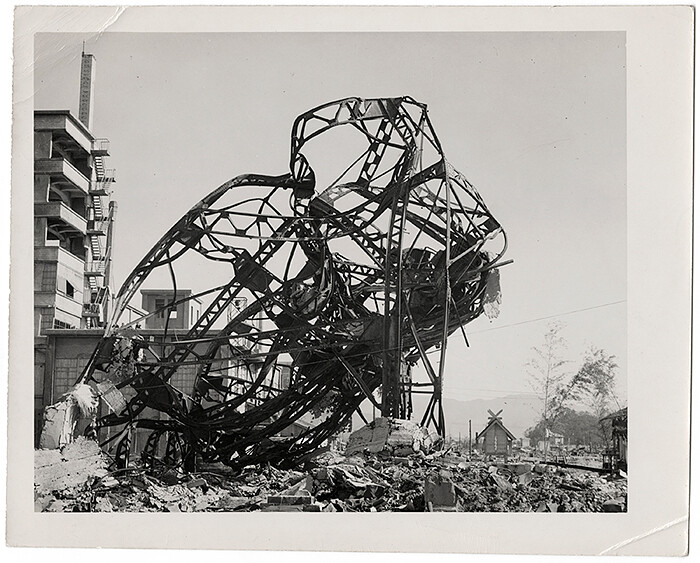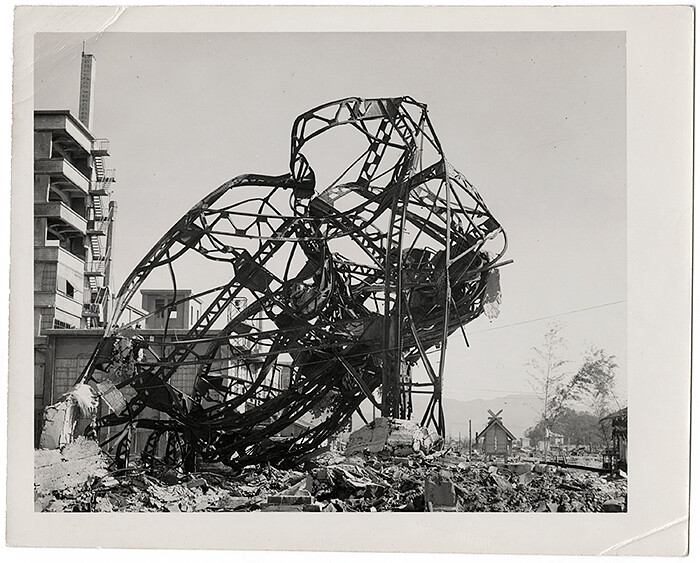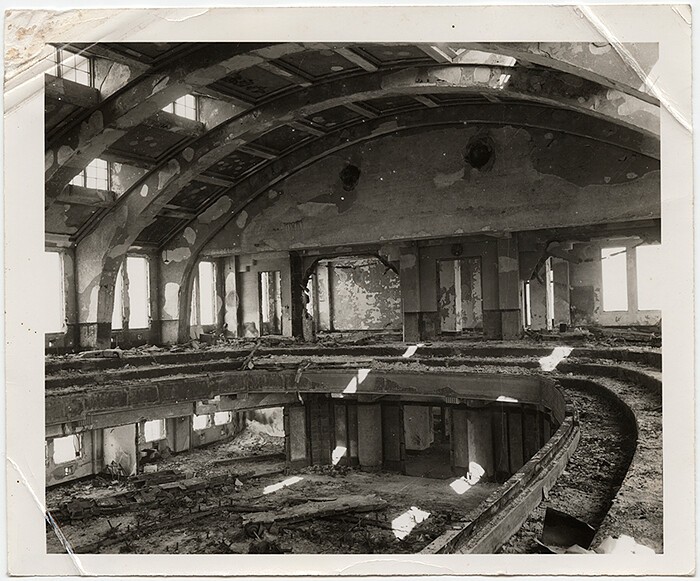At 8:15 on the morning of August 6, 1945, the Japanese city of Hiroshima was momentarily “covered by a bluish-white glare.” (1) An atom bomb, the first to be dropped on a human population, had exploded 580 meters above the ground. A 4.4-square-mile section of the city center was more or less instantly flattened, and subsequent fires, which raged for more than eight hours, consumed much of what hadn’t been pulverized by the bomb’s concussive force. It is now estimated that nearly two-thirds of the approximately 76,000 buildings in Hiroshima were completely destroyed or burned; approximately 70,000, or more than nine out of ten, were at least “half-destroyed/half-burned/slightly damaged.” Soot from the fires, along with dirt and mud, was swept up into the air by whirlwinds and returned to earth as highly toxic, sticky “black rain.” Those who happened to be within 1.2 kilometers of the detonation point (known as “air zero”) had only a fifty percent chance of surviving; any closer and the mortality rates jumped to between eighty and one hundred percent. The city’s population that August is estimated to have been 340,000, and it is now believed that approximately 140,000 people died as a result of the bomb. These are the accepted facts about the devastation wrought in Hiroshima, ostensibly to bring the war with Japan, and thus World War II, to a close. A second bomb was dropped on Nagasaki three days later, killing an additional 80,000 people, and on August 15 Emperor Hirohito announced his country’s surrender.
We know what such explosions look like: a tall stem of smoke and debris, often several miles high, that disperses horizontally once it reaches sufficient altitude. While volcanic eruptions can cause these mushroom-shaped clouds, they are most closely associated with nuclear detonations. The United States government conducted hundreds of nuclear-bomb tests between 1945 and 1962, and images of the explosions have passed from the realm of scientific and military documentation into the broader culture. The mushroom cloud is the icon of the nuclear age.
It is much harder, however, to picture what the devastation in Hiroshima and Nagasaki looked like. This is not for lack of visual evidence. Japanese photographers catalogued the grim aftermath of concrete rubble and seared skin. A companion plane laden with photographic equipment, later dubbed Necessary Evil, accompanied the Enola Gay on the fateful mission that dropped the bomb. Hiroshima was targeted, at least in part, because its infrastructure presented a near-ideal environment in which to study the effects of the bomb, and after the attack President Truman duly sent members of the United States Strategic Bombing Survey (USSBS) to Japan. A team of photographers made over 1,100 images, two-thirds of which were included in a secret three-volume report submitted to the government in 1947. Such images, however, despite occasionally appearing in books and other public venues, have not permeated Western consciousness. The presentation at the International Center of Photography of several dozen photographs from the USSBS archive is therefore a chance to become better acquainted with the fearsome power at human disposal.
These small, black-and-white pictures were taken with technical rather than aesthetic intent. The seven photographers were interested in the effects of the bomb on the built environment, and therefore few people appear in the images. Most of the photographs are portraits of commercial or civic buildings; and because residential structures were typically made of wood, so few of them survived that the photographers did not document them. Standing amid the rubble is the façade and dome of the city’s commercial exhibition hall. So, too, is the coal-distribution company headquarters, the front of which seems to have been punched into the ground. There are views of school buildings, banks, insurance company headquarters, and the interior of Hiroshima City Hall’s auditorium, barren save for a fine layer of burned litter scattered across the main floor and balcony. Other photographs provide dramatic context for the close-ups and interior views. To make them, the photographers ascended to upper-story windows or the roofs of standing buildings and pointed the camera lens outward at the desolate landscape. Because Hiroshima lies on a large, flat plain, the photographers could see relatively far into the distance. The horizon line is the meeting point of two undifferentiated shades of gray: on the one hand, the mostly featureless sky, and, on the other, the uninterrupted expanse of dusty concrete and plaster that once was a great city. The “burned-over area,” as it was called, extends all the way to the horizon, and it is in these pictures that viewers can most clearly discern the scale of the devastation.
A map presented in the gallery allows viewers to reconstruct some of the scientific findings of the photographers. Reproduced from a USSBS report, it includes not only lines demarcating the physical extent of the devastation but also points indicating the location of the buildings depicted in the photographs. For example, buildings closer to ground zero (the point directly beneath the detonation) were likely to suffer from collapsed roofs or other structural damage that indicates the downward pressure of the blast. Those farther away were subject to the horizontal force of the explosion: normally upright steel beams torque away from ground zero as if blasted by strong winds. Farther away still, tree trunks and telephone poles remain upright, but the former have been shorn of all their branches. Their unnatural look is a reminder that the earth which once nourished them had been irradiated.
The most complex and haunting photographs in the show, however, depict “flash burns.” In one image, the shadow of a valve used to seal off a pipe is projected onto the metal surface of the container to which it is attached. Visual habit leads viewers to believe that this is the effect of a sunny day. The caption belies this commonsense response: “‘Shadow’ of a hand valve wheel on the painted wall of a gas storage tank; radiant heat instantly burned paint where the heat rays were not obstructed.” In effect, the nuclear blast—its “bluish white glare”—turned some objects in Hiroshima into light-sensitive surfaces, resulting in what might technically if uneasily be called photograms. I say uneasily because of another, altogether sadder image also included in the show. Here we see the surface of a road, on which an arrow is chalked and labeled “direction of blast.” Once again the caption, its neutral language betraying the photograph’s scientific purpose, redirects our understanding of the image: “Flash-burn on asphalt on bridge 20, 3,500 feet south from [air zero]. Shadow was cast by a man.” Two small circles marked in chalk indicate the placement of the man’s feet; one is slightly in front of the other, as if he were mid-stride. The “shadow,” this photogram-within-a-photograph, is likely the only extant evidence that someone died on that spot.
New York museum-goers have recently had one other opportunity to consider the effects of the Hiroshima bombing. The 2005 Japan Society exhibition “Little Boy,” curated by artist Takashi Murakami, examined some of the artistic and cultural fallout of the 1945 attacks. (Its title came from the nickname of the bomb dropped on Hiroshima.) The terrible details disclosed by the photographs at ICP give ballast to that earlier show. These pictures were originally meant to document the bomb’s effects and were used in the service of bettering civil defense architecture in the United States, yet seeing them in a public museum, shorn of their narrowly utilitarian purpose, allows them to serve other functions. These photographs can, for example, give specificity to debates over the proliferation and potential abuse of nuclear weapons, a prospect that will haunt us until we dismantle the bombs. Their presentation also affords us an arena to debate the contrary claims of secrecy and transparency upon government actions. So, too, do they give us the chance to consider the necessity of such Necessary Evils, their moral and ethical implications. More than six decades have passed since we dropped the bomb, making this a politically safer exhibition for the museum to mount than its autumn 2004 show of Iraqi prison photographs from Abu Ghraib. “Hiroshima Ground Zero” is nonetheless in line with that earlier, daring curatorial effort, and reveals that temporal distance hardly depletes the shock of the images themselves.
(1). The Committee for the Compilation of Materials on Damage Caused by the Atomic Bombs in Hiroshima and Nagasaki, Hiroshima and Nagasaki: The Physical, Medical, and Social Effects of the Atomic Bombings, trans. Eisei Ishikawa and David L. Swain (New York: Basic Books, 1981), 21. Additional details about the bombing and its effects described in the text are drawn from this volume.






